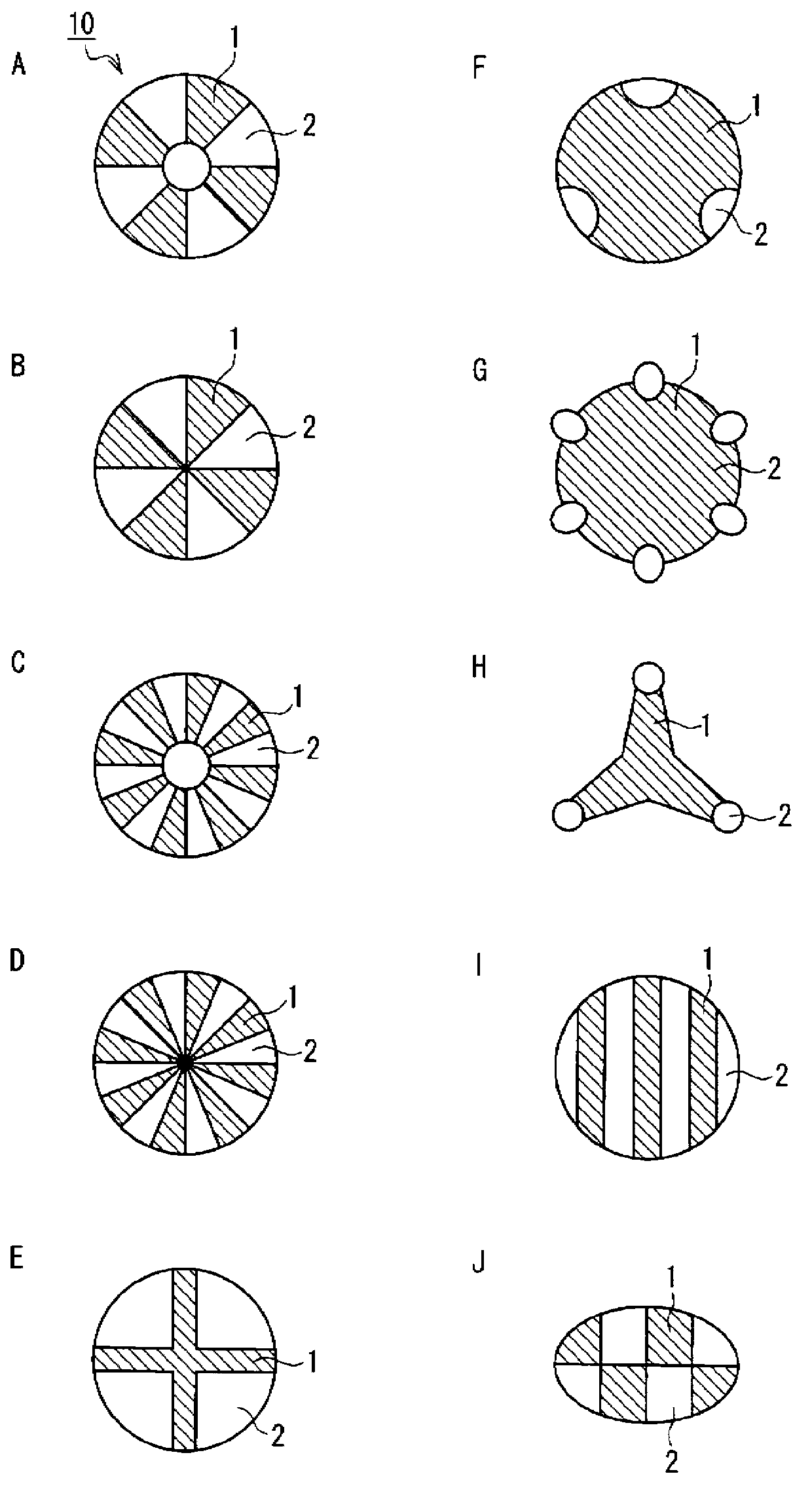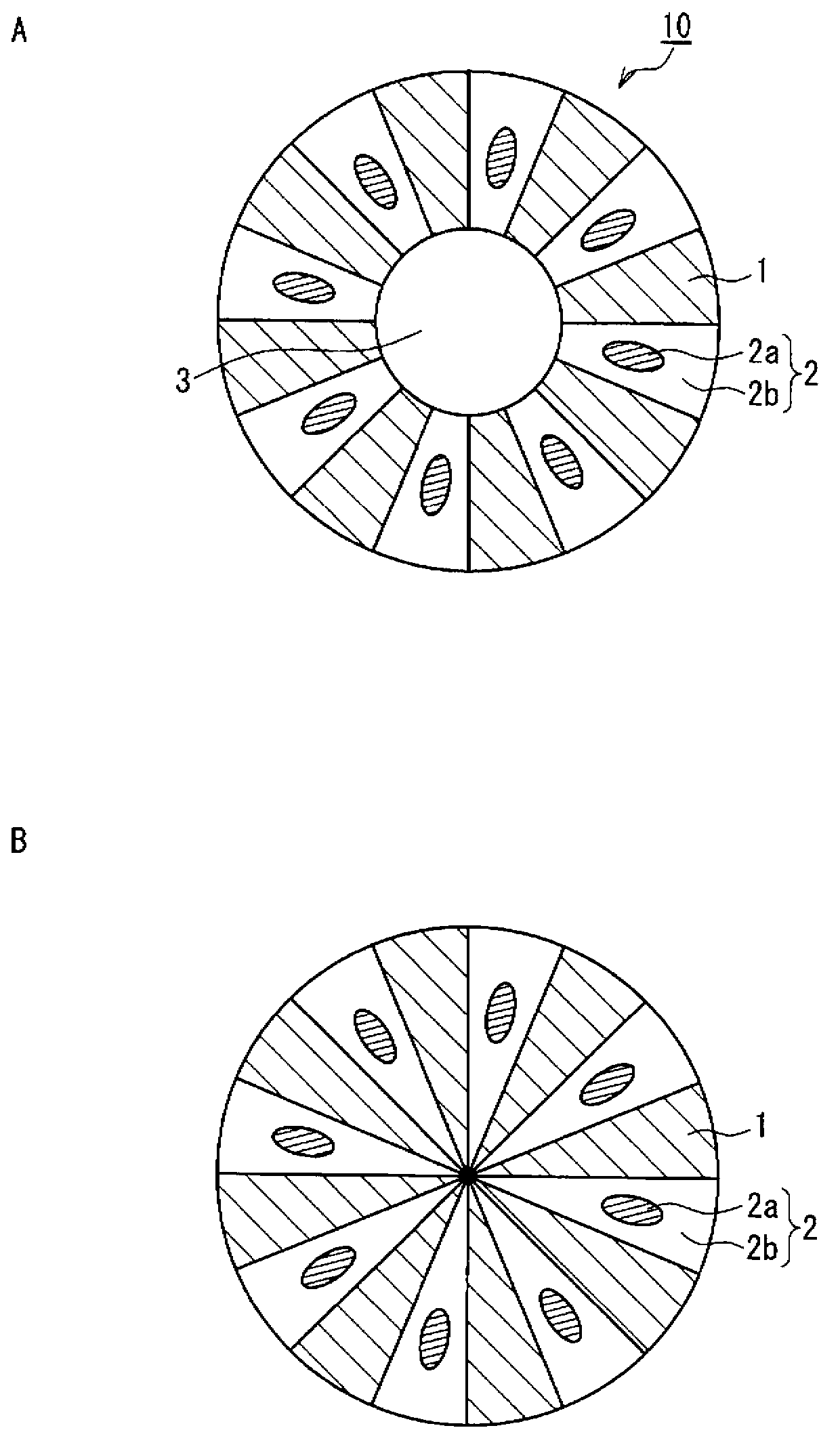Polyolefin-based split-type conjugate fibre, fibrous mass and cell separator using same, and production method for same
A composite fiber, manufacturing method technology, applied in the direction of conjugated synthetic polymer rayon, fiber processing, secondary battery, etc., to achieve the effects of high puncture strength, excellent stretchability and splitability
- Summary
- Abstract
- Description
- Claims
- Application Information
AI Technical Summary
Problems solved by technology
Method used
Image
Examples
Embodiment 1)
[0160] As the first component, a homopolypropylene resin with a Q value of 10.7, Mn of 51,000, Mw of 540,000, Mz of 3,000,000, MFR230 of 10 g / 10 minutes, and a tensile modulus of 2,400 MPa was used as the second component. Polymethylpentene-based resin having a melting point of 238° C., an MFR260 of 180 g / 10 minutes, a tensile elastic modulus of 1765 MPa, and a Rockwell hardness of 90 ("DX820" manufactured by Mitsui Chemicals). Next, the composite ratio (volume ratio) of the first component and the second component was set to 5:5, and the first component was melt-spun at a spinning temperature of 350° C., and the second component was melt-spun using a hollow 8-split composite spinneret. The ingredients are melt-spun at a spinning temperature of 280°C to obtain a denier of 10dtex and as figure 1 The cross-section of the fiber shown in A is a gear-shaped, undrawn split-type conjugate fiber (undrawn fiber bundle, spun filament) with 8 splits (hereinafter referred to as hollow 8-s...
Embodiment 2)
[0164] Melt spinning is carried out under the same conditions as in Example 1, and the undrawn fiber bundle obtained is stretched at a draw ratio of 5.9 times under the same temperature conditions as in Example 1 to obtain a fineness of 1.7dtex , Split-type composite fiber with a hollow rate of 20%. In addition, the draw ratio was 78.7% of the maximum draw ratio. A wet-laid nonwoven fabric was obtained in the same manner as in Example 1 using the obtained split-type conjugated fibers. In the obtained wet-laid nonwoven fabric, the split ratio of the split-type conjugate fibers was 60%. In addition, an interwoven nonwoven fabric was obtained from a wet-laid nonwoven fabric in the same manner as in Example 1. In the obtained entangled nonwoven fabric, the split ratio of the split type conjugate fibers was 100%.
Embodiment 3)
[0166] When performing melt spinning, as a spinning spinneret, a composite spinneret of a solid 8-split type without a hollow portion is used, except that, under the same conditions as in Example 1, melt spinning is carried out to obtain a fineness of 10dtex, the cross-sectional shape is asfigure 1 The cross-section of the fiber shown in B is a gear-shaped undrawn fiber bundle (spun filament) having 8 divisions without a hollow portion. The resulting undrawn fiber bundle (spun filament) was stretched at a draw ratio of 5.9 times under the same temperature conditions as in Example 1 to obtain a solid 8-split split type with a fineness of 1.7 dtex Composite fibers. In addition, the draw ratio was 78.7% of the maximum draw ratio. A wet-laid nonwoven fabric was obtained in the same manner as in Example 1 using the obtained split-type conjugated fibers. In the obtained wet-laid nonwoven fabric, the split ratio of the split type conjugate fibers was 55%. In addition, an interwove...
PUM
| Property | Measurement | Unit |
|---|---|---|
| melting point | aaaaa | aaaaa |
| strength | aaaaa | aaaaa |
| thickness | aaaaa | aaaaa |
Abstract
Description
Claims
Application Information
 Login to View More
Login to View More - R&D
- Intellectual Property
- Life Sciences
- Materials
- Tech Scout
- Unparalleled Data Quality
- Higher Quality Content
- 60% Fewer Hallucinations
Browse by: Latest US Patents, China's latest patents, Technical Efficacy Thesaurus, Application Domain, Technology Topic, Popular Technical Reports.
© 2025 PatSnap. All rights reserved.Legal|Privacy policy|Modern Slavery Act Transparency Statement|Sitemap|About US| Contact US: help@patsnap.com



